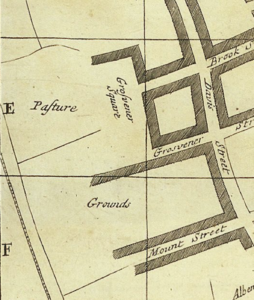Place Name

Sir Richard Grosvenor, 4th Baronet (June 26, 1689 – July 12, 1732) was the third son, and eldest surviving heir, of Sir Thomas Grosvenor and Mary Davies, the young woman who had inherited a large area of swampy and seemingly worthless land to the north of the River Thames. Today that area is Mayfair, Park Lane and Belgravia. He succeeded to his father’s title in 1700 having outlived both his older brothers, Thomas and Roger. Like his father before him, Richard was still a boy when his father died. He remained at Eton under the guardianship of Sir Richard Myddelton and Thomas and Francis Cholmondeley. On leaving school he went on the Grand Tour, visiting Switzerland, Bavaria, Italy and the Netherland, returning to the family’s country seat Eaton Hall, Cheshire, in 1707. In 1715 he was elected as Member of Parliament for Chester, a seat he held until his death. In the same year he became mayor of the city. It was during his time that the Grosvenor family’s estates began to be developed. On July 12, 1725 the Daily Post, reported: “The several new streets designed in Grosvenor Buildings in the Parish of St George, Hanover Square, and lying between New Bond Street and Hyde Park were last week particularly named; upon which occasion Sir Richard Grosvenor, Bart, gave a very splendid entertainment to his tenants and others concerned with those buildings… In the centre of those new buildings there is now making a new square called Grosvenor Square [with gardens designed by William Kent], which for its largeness and beauty will far exceed any yet made in or about London.” Outside of his political and business interests, he also founded the family’s interests with horse racing, with horses running at Chester and Newmarket in 1720. In his personal life he had married Jane, the daughter of Sir Edward Wyndham of Orchard Wyndham, Somerset, in 1708. The couple had one daughter, Catherine, who died in 1718. During the following year, Jane Grosvenor died and Grosvenor then married Diana, the only daughter of Sir George Warburton, 3rd Baronet Arley. Again, they had no children. He was therefore succeeded by his younger brother, Thomas, who in turn died later the same year. The name Grosvenor is derived from Hugh Le Grand Veneur (literally Master Huntsman), a member of a Norman French family that came over with William the Conqueror (he was his nephew) in 1066. Initially, Hugh was called Hugh Lupus. Lupus was overweight, and his townsmen gradually changed his title from Le Grand Veneur to Le Gros Veneur – meaning the Fat Huntsman, a title he evidently took pride in.
![]()
